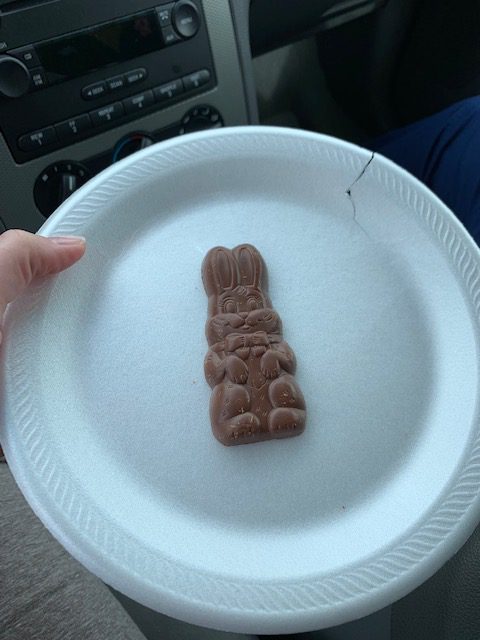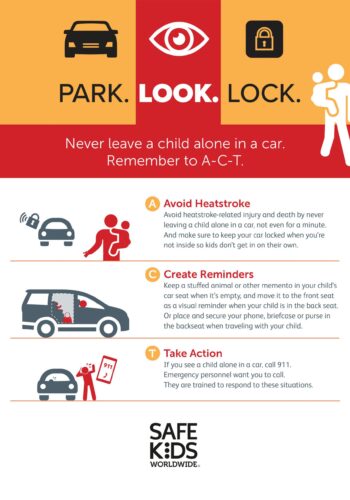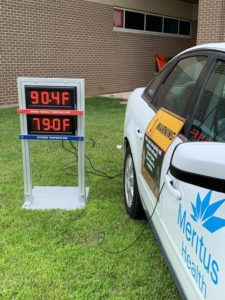On a nice day in Maryland, little bunny went outside to play hide and go seek with his friends.
No, that’s not right.
One sunny day in Maryland, a caregiver bunny and little bunny ran to the store, little bunny was sleeping and caregiver bunny knew they would only be gone for a quick minute.
No, that is not right either.
Oh yes, I know how the story goes. On a sunny spring day in Maryland, little bunny ended up in a vehicle and was unable to get out. As you can see little bunny quickly melted much to the shock of love ones all around. A melting that was 100% preventable. If this idea of a melted bunny seems silly, it really is anything but. Imagine now that this “bunny” is a child, the story ends the same way except instead of a melted chocolate bunny, we have a deceased child.


Sadly, this is what occurs every year in our country, far too many times. A child, for one of many reasons, remains in a car too long and dies. Over half of child vehicular deaths in the last 23 years (1998 to 2020) has been a forgotten by a caregiver. (Noheatstroke.org, 2021). A quarter of the child vehicular deaths were by children gaining access into a vehicle on their own (Noheastroke.org, 2021), sadly 19.7% of the time a child was knowingly left in the vehicle and 1.7% of the time, the cause is unknown (Noheastroke.org, 2021).
All of these deaths preventable? Absolutely, yes.
In 2020, there were 24 hot car deaths, 24 children died but did not have to. Isn’t there something that can be done to prevent these senseless deaths? Absolutely. You can remember to always ACT.

Safe Kids Worldwide (2021), recommends following the acronym ACT to help prevent heatstroke vehicular deaths.
A: Avoid heat-stroke related injuries, by never leaving a car alone and ensuring your vehicle is always locked.
C: Create reminders to help remember to check your back seat.
T: Take action – Call 911 and save a life.
Never ever leave a child in a car alone. A quick “run into the store” can quickly result in death of a child. Do not be miss led, a cracked window will not prevent the inside of a vehicle from heating up to dangerous and deadly temperatures.
On any given day, even on a “cool” day, it only takes about 10 minutes for the inside of a vehicle to heat up 20 degrees (Safe Kids Worldwide, 2021). As the body temperature rises, mental status starts to decrease, problem solving becomes challenging. The simple task of hitting a button to unlock a door becomes impossible.

A child’s body heats up three to five times faster than adults, meaning that their body temperature can quickly reach 104 degrees very quickly. What is significant about this temperature? 104 degrees is when the brain and major organs start to shut down. Only three degrees higher at 107 and death occurs.
In a world where we are constantly multitasking, it is important for adults to be vigilant in preventing these deaths. As adults, we have to remember to slow down and act with intent for prevention.
Maybe you thought to yourself, “I’m just running in to grab dinner from my favorite restaurant and my child fell asleep on the way. Surely, my sleeping child will be okay in a vehicle for “just a minute?” The answer is always, no!
Remember to always lock your car doors and put the keys up and away, out of sight from small children. While a key fob is convenient for adults, it is a hidden danger for kids. They can easily swipe your keys off the counter and enter the vehicle without much knowledge to an adult.
Have you arrived at work, only to forget your coffee or cell phone at home on the counter? Frustrating, yes, but harmful? No.
Creating reminders can be a life-saving action, the difference between a died or saved child in a vehicle. Place an item in the backseat that you will need when you arrive at your destination, such as leaving your phone beside the child in the backseat (also, a great way to stay hands-free while driving). Or place a gym bag, brief case, or a shoe you are wearing. I know I won’t make it across the parking lot in one heel! If your child goes to daycare, set reminder system with the daycare center, for them to call if your child has not arrived by a certain time.
Think leaving a child in a car unintentionally is only for uneducated, unloving parents? Think again. Many children who have died from being left unintentionally in vehicles, had well-educated, career oriented parents, who loved their children beyond belief. Creating reminders and acknowledging that leaving a child in a car unintentionally, could happen to you.
How many times have we thought, “someone else will call 911 or someone else already did call 911?” Stop that thinking. If you see a child in a vehicle, call 911! Never presume someone already has or that the situation is going to be “okay.” A child left in a vehicle is counting on YOU to help them! Call 911 and stay on scene until the situation is resolved. Be the difference to that child and family and save a child’s life.
Remember, even on the mildest of days, the inside of a vehicle can heat up rapidly. Enough to melt a bunny? Yes. Enough to kill a child? Yes!
I challenge each of you to keep a watchful eye out, stay vigilant and to not only follow these safety tips yourself, but to share with at least one other person this information. If we can spread preventative measures, we can decrease the vehicular heatstroke deaths to ZERO. It is time to prevent melting bunnies and dying children from vehicular heatstroke deaths.
References
Safe Kids Worldwide (2021). Heatstroke talking points. https://safekids.org/file/heatstroke-talking-points
NoHeatstroke.org (2021). Heatstroke deaths of children in vehicles. https://www.noheatstroke.org/index.htm
This blog post is brought to you by Kelly Llewellyn, Injury Prevention Specialist at Meritus Health and Safe Kids Washington County Co-Coordinator.


